Genetically Optimized Pitch Angle Controller of a Wind Turbine with Fuzzy Logic Design Approach
Abstract
:1. Introduction
2. Methodology
2.1. Modeling of a Turbine
2.2. DFIG Type Wind Turbine Configuration and Modeling
2.3. Fuzzy Logic Controller
2.4. Genetic Algorithm Optimization of Fuzzy Logic Control
3. Implementation Results and Discussion
4. Conclusions
Author Contributions
Funding
Institutional Review Board Statement
Informed Consent Statement
Data Availability Statement
Conflicts of Interest
References
- Civelek, Z.; Lüy, M.; Çam, E.; Mamur, H. A New Fuzzy Logic Proportional Controller Approach Applied to Individual Pitch Angle for Wind Turbine Load Mitigation. Renew. Energy 2017, 111, 708–717. [Google Scholar] [CrossRef]
- Lasheen, A.; Elshafei, A.L. Wind-Turbine Collective-Pitch Control via a Fuzzy Predictive Algorithm. Renew. Energy 2016, 87, 298–306. [Google Scholar] [CrossRef]
- Iqbal, A.; Ying, D.; Saleem, A.; Hayat, M.A.; Mehmood, K. Efficacious Pitch Angle Control of Variable-Speed Wind Turbine Using Fuzzy Based Predictive Controller. Energy Rep. 2020, 6, 423–427. [Google Scholar] [CrossRef]
- Van, T.L.; Nguyen, T.H.; Lee, D.-C. Advanced Pitch Angle Control Based on Fuzzy Logic for Variable-Speed Wind Turbine Systems. IEEE Trans. Energy Convers. 2015, 30, 578–587. [Google Scholar] [CrossRef]
- Kamel, R.M.; Chaouachi, A.; Nagasaka, K. Enhancement of Micro-Grid Performance during Islanding Mode Using Storage Batteries and New Fuzzy Logic Pitch Angle Controller. Energy Convers. Manag. 2011, 52, 2204–2216. [Google Scholar] [CrossRef]
- Musyafa’, A.; Harika, A.; Negara, I.M.; Robandi, I. Pitch Angle Control of Variable Low Rated Speed Wind Turbine Using Fuzzy Logic Controller. Int. J. Eng. Technol. 2013, 10, 21–24. [Google Scholar]
- Zhang, J.; Cheng, M.; Chen, Z.; Fu, X. Pitch Angle Control for Variable Speed Wind Turbines. In Proceedings of the 2008 Third International Conference on Electric Utility Deregulation and Restructuring and Power Technologies, Nanjing, China, 6–9 April 2008; pp. 2691–2696. [Google Scholar]
- Elfergani, A.; Elsharif, M.A.A.; Hamd, R.H.A.; Saad, S.M.; Naily, N.E.; Mohamed, F.A. Advanced Self-Tuned Pitch Angle Control Based on Fuzzy Logic for Grid Connected Variable-Speed Wind Turbine System. In Proceedings of the 2018 9th International Renewable Energy Congress (IREC), Hammamet, Tunisia, 20–22 March 2018; pp. 1–6. [Google Scholar]
- Kesraoui, M.; Lagraf, S.A.; Chaib, A. Aerodynamic Power Control of Wind Turbine Using Fuzzy Logic. In Proceedings of the 2015 3rd International Renewable and Sustainable Energy Conference (IRSEC), Marrakech, Morocco, 10–13 December 2015; pp. 1–6. [Google Scholar]
- Shrinath, K.; Paramasivam, S.; Palanisamy, K. An Intelligent Self-Tuning Fuzzy Logic Controller for Pitch Angle Control for a Wind Turbine Fed Induction Generator. In Proceedings of the 2017 Innovations in Power and Advanced Computing Technologies (i-PACT), Vellore, India, 21–22 April 2017; pp. 1–5. [Google Scholar]
- Karimi-Davijani, H.; Sheikholeslami, A.; Livani, H.; Karimi, M. Fuzzy Logic Control of Doubly Fed Induction Generator Wind Turbine. World Appl. Sci. J. 2009, 6, 499–508. [Google Scholar] [CrossRef]
- Goyal, S.; Gaur, M.; Bhandari, S. Power Regulation of a Wind Turbine Using Adaptive Fuzzy-PID Pitch Angle Controller. Int. J. Recent Technol. Eng. 2013, 2, 128–132. [Google Scholar]
- Ngo, Q.-V.; Yi, C.; Nguyen, T.-T. The Fuzzy-PID Based-Pitch Angle Controller for Small-Scale Wind Turbine. IJPEDS 2020, 11, 135. [Google Scholar] [CrossRef]
- Ali, M.M.M.; Youssef, A.-R.; Abdel-Gaber, G.; Ali, A.S. Adaptive Fuzzy-PID Based Pitch Angle Control of Wind Turbine. In Proceedings of the 2018 Twentieth International Middle East Power Systems Conference (MEPCON), Cairo, Egypt, 18–20 December 2018; pp. 1110–1114. [Google Scholar]
- Duong, M.Q.; Grimaccia, F.; Leva, S.; Mussetta, M.; Ogliari, E. Pitch Angle Control Using Hybrid Controller for All Operating Regions of SCIG Wind Turbine System. Renew. Energy 2014, 70, 197–203. [Google Scholar] [CrossRef]
- Gao, F.; Xu, D.; Lv, Y. Pitch-Control for Large-Scale Wind Turbines Based on Feed Forward Fuzzy-PI. In Proceedings of the 2008 7th World Congress on Intelligent Control and Automation, Chongqing, China, 25–27 June 2008; 2008; pp. 2277–2282. [Google Scholar]
- Garasi, P.; Watanabe, M.; Mitani, Y. Power Smoothing of Wind Turbine Generator Using Fuzzy-PI Pitch Angle Controller. In Proceedings of the 2014 Australasian Universities Power Engineering Conference (AUPEC), Perth, Australia, 28 September 2014; pp. 1–5. [Google Scholar]
- Qi, Y.; Meng, Q. The Application of Fuzzy PID Control in Pitch Wind Turbine. Energy Procedia 2012, 16, 1635–1641. [Google Scholar] [CrossRef]
- Baburajan, S. Improving the Efficiency of a Wind Turbine System Using a Fuzzy-Pid Controller. In Proceedings of the 2018 Advances in Science and Engineering Technology International Conferences (ASET), Dubai, United Arab Emirates, 6 February 2018; pp. 1–5. [Google Scholar]
- Maroufi, O.; Choucha, A.; Chaib, L. Hybrid Fractional Fuzzy PID Design for MPPT-Pitch Control of Wind Turbine-Based Bat Algorithm. Electr. Eng. 2020, 102, 2149–2160. [Google Scholar] [CrossRef]
- Sahoo, S.; Subudhi, B.; Panda, G. Pitch Angle Control for Variable Speed Wind Turbine Using Fuzzy Logic. In Proceedings of the 2016 International Conference on Information Technology (ICIT), Bhubaneswar, India, 22–24 December 2016; pp. 28–32. [Google Scholar]
- Sahoo, S.; Subudhi, B.; Panda, G. Torque and Pitch Angle Control of a Wind Turbine Using Multiple Adaptive Neuro-Fuzzy Control. Wind Eng. 2020, 44, 125–141. [Google Scholar] [CrossRef]
- Veeramani, C.; Mohan, G.M. A fuzzy based pitch angle control for variable speed wind turbines. Int. J. Eng. Technol. 2013, 5, 1699–1703. [Google Scholar]
- Senjyu, T.; Sakamoto, R.; Urasaki, N.; Funabashi, T.; Sekine, H. Output Power Leveling of Wind Farm Using Pitch Angle Control with Fuzzy Neural Network. In Proceedings of the 2006 IEEE Power Engineering Society General Meeting, Montreal, QC, Canada, 18–22 June 2006; p. 8. [Google Scholar]
- Chen, C.H.; Hong, C.-M.; Ou, T.-C. Hybrid Fuzzy Control of Wind Turbine Generator by Pitch Control Using RNN. Int. J. Ambient Energy 2012, 33, 56–64. [Google Scholar] [CrossRef]
- Dongran, S.; Yanping, T.; Lei, W. Coordinated optimization on energy capture and torque fluctuation of wind turbine via variable weight NMPC with fuzzy regulator. Appl. Energy 2022, 312, 118821. [Google Scholar]
- Adel, M. Adaptive Sliding Mode Control for Wind Energy Experimental. System. Energies 2018, 11, 2238. [Google Scholar] [CrossRef]
- Ram, K.R.; Lal, S.P.; Ahmed, M.R. Design and Optimization of Airfoils and a 20 KW Wind Turbine Using Multi-Objective Genetic Algorithm and HARP_Opt Code. Renew. Energy 2019, 144, 56–67. [Google Scholar] [CrossRef]
- Tahani, M.; Sokhansefat, T.; Rahmani, K.; Ahmadi, P. Aerodynamic Optimal Design of Wind Turbine Blades Using Genetic Algorithm. Energy Equip. Syst. 2014, 2, 185–193. [Google Scholar] [CrossRef]
- Hall, M.; Buckham, B.; Crawford, C. Evolving Offshore Wind: A Genetic Algorithm-Based Support Structure Optimization Framework for Floating Wind Turbines. In Proceedings of the 2013 MTS/IEEE OCEANS-Bergen, Bergen, Norway, 10–14 June 2013; pp. 1–10. [Google Scholar]
- Attia, A.-F.; Soliman, H.; Sabry, M. Genetic Algorithm Based Control System Design of a Self-Excited Induction Generator. Acta. Polytech. 2006, 46, 8. [Google Scholar] [CrossRef]
- Ali, E.S. Speed Control of Induction Motor Supplied by Wind Turbine via Imperialist Competitive Algorithm. Energy 2015, 89, 593–600. [Google Scholar] [CrossRef]
- Das, D.C.; Roy, A.; Sinha, N.; Member, S. Genetic Algorithm Based PI Controller for Frequency Control of an Autonomous Hybrid Generation System. In Proceedings of the International MultiConference of Engineers and Computer Scientists, Hong Kong, 16–18 March 2011. [Google Scholar]
- Lara, M.; Garrido, J.; Ruz, M.L.; Vázquez, F. Adaptive Pitch Controller of a Large-Scale Wind Turbine Using Multi-Objective Optimization. Appl. Sci. 2021, 11, 2844. [Google Scholar] [CrossRef]
- Zahra, B.; Salhi, H.; Mellit, A. Wind Turbine Performance Enhancement by Control of Pitch Angle Using PID Controller and Particle Swarm Optimization. In Proceedings of the 2017 5th International Conference on Electrical Engineering-Boumerdes (ICEE-B), Boumerdes, Algeria, 29–31 October 2017; pp. 1–5. [Google Scholar]
- Lee, J.; Son, E.; Hwang, B.; Lee, S. Blade Pitch Angle Control for Aerodynamic Performance Optimization of a Wind Farm. Renew. Energy 2013, 54, 124–130. [Google Scholar] [CrossRef]
- Belghazi, O.; Cherkaoui, M. Pitch Angle Control for Variable Speed Wind Turbines Using Genetic Algorithm Controller. J. Theor. Appl. Inf. Technol. 2012, 39, 6–10. [Google Scholar]
- Belghazi, O.; Douiri, M.R.; Cherkaoui, M. Power control of a wind energy based on a DFIG by sliding mode approach and pitch angle optimal control by genetic algorithm. J. Achiev. Mater. Manuf. Eng. 2016, 74, 78–85. [Google Scholar] [CrossRef]
- Paraschivoiu, I.; Trifu, O.; Saeed, F. H-Darrieus Wind Turbine with Blade Pitch Control. Int. J. Rotat. Mach. 2009, 2009, 1–7. [Google Scholar] [CrossRef]
- Li, D.-Y.; Cai, W.-C.; Li, P.; Jia, Z.-J.; Chen, H.-J.; Song, Y.-D. Neuroadaptive Variable Speed Control of Wind Turbine with Wind Speed Estimation. IEEE Trans. Ind. Electron. 2016, 63, 7754–7764. [Google Scholar] [CrossRef]
- Gonzalez, J.S.; Payan, M.B. Jesus Riquelme Santos Optimum Wind Turbines Operation for Minimizing Wake Effect Losses in Offshore Wind Farms. In Proceedings of the 2013 13th International Conference on Environment and Electrical Engineering (EEEIC), Wroclaw, Poland, 1–3 November 2013; pp. 188–192. [Google Scholar]
- Vrionis, T.D.; Koutiva, X.I.; Vovos, N.A. A Genetic Algorithm-Based Low Voltage Ride-Through Control Strategy for Grid Connected Doubly Fed Induction Wind Generators. IEEE Trans. Power Syst. 2014, 29, 1325–1334. [Google Scholar] [CrossRef]
- Attia, A.-F.; Al-Turki, Y.A.; Soliman, H.F. Genetic Algorithm-Based Fuzzy Controller for Improving the Dynamic Performance of Self-Excited Induction Generator. Arab. J. Sci. Eng. 2012, 37, 665–682. [Google Scholar] [CrossRef]
- Lotfy, M.; Senjyu, T.; Farahat, M.; Abdel-Gawad, A.; Lei, L.; Datta, M. Hybrid Genetic Algorithm Fuzzy-Based Control Schemes for Small Power System with High-Penetration Wind Farms. Appl. Sci. 2018, 8, 373. [Google Scholar] [CrossRef]
- Burakov, M.; Shishlakov, V. Genetic Algorithm Optimization for Pitch Angle Control of Variable Speed Wind Turbines. MATEC Web Conf. 2017, 113, 01009. [Google Scholar] [CrossRef]
- Zheng, S.-G.; Chang, C.-K.; Pan, J.-S. Double Fuzzy Pitch Controller of Wind Turbine Designed by Genetic Algorithm. In Proceedings of the 2020 International Automatic Control Conference (CACS), Hsinchu, Taiwan, 4 November 2020; IEEE: Hsinchu, Taiwan; pp. 1–5. [Google Scholar]
- Civelek, Z. Optimization of Fuzzy Logic (Takagi-Sugeno) Blade Pitch Angle Controller in Wind Turbines by Genetic Algorithm. Eng. Sci. Technol. Int. J. 2020, 23, 1–9. [Google Scholar] [CrossRef]
- Frede, B.; Dan, M.I. Renewable Energy Devices and Systems with Simulations in MATLAB and Ansys; Taylor& Francis Group, CRC Press: Boca Raton, FL, USA, 2017. [Google Scholar]
- Paul, M.-G.; Hamane, B.; Mamadou, D. Pitch Control of a Wind Energy Conversion System Based on Permanent Magnet Synchronous Generator (PMGS). In Proceedings of the 2015 Tenth International Conference on Ecological Vehicles and Renewable Energies (EVER), Monte Carlo, Monaco, 1 November 2015. [Google Scholar] [CrossRef]
- Miller, B.L.; Goldberg, D.E. Genetic Algorithms, Tournament Selection, and the Effects of Noise. Complex Syst. 1995, 9, 193–212. [Google Scholar]
- Hasanat, A.; Almohammadi, K.; Alkafaween, E.; Abunawas, E.; Hammouri, A.; Prasath, V.B.S. Choosing Mutation and Crossover Ratio for Genetic Algorithms-A review with a New Dynamic Approach. Information 2019, 10, 309. [Google Scholar] [CrossRef]
- Mohamat, F.; Kamel, S.; Atallah, A.M.; Khan, B. Developing a marine predator algorithm for optimal power flow analysis considering uncertainty of renewable energy sources. Int. Trans. Electr. Energy Syst. 2022, 2022, 3714475. [Google Scholar] [CrossRef]
- Xueming, Y.; Yuan, J.; Yuan, J.; Mao, H. A modified particle swarm optimizer with dynamic adaptation. Appl. Math. Comput. 2007, 189, 1205–1213. [Google Scholar] [CrossRef]
- Esmat, R.; Nezamabadi-Pour, H.; Saryazdi, S. GSA: A gravitational search algorithm. Inf. Sci. 2009, 179, 2232–2248. [Google Scholar] [CrossRef]
- Xin, S.; Suash, D. Cuckoo Search via Levy Flights. In Proceedings of the World Congress on Nature & Biologically Inspired Computing (NaBIC 2009), Coimbatore, India, 9–11 December 2009. [Google Scholar]
- Nur, J.; Zain, A.M.; Noorfa, M.H.; Udin, A. Firefly algorithm for optimization problem. Appl. Mech. Mater. 2013, 421, 512–517. [Google Scholar] [CrossRef]
- Afshin, F.; Heidarinejad, M.; Mirjalili, S.; Gandomi, A.H. Marine predators algorithm: A nature-inspired metaheuristic. Expert Syst. Appl. 2020, 152, 113377. [Google Scholar] [CrossRef]
- Dongran, S.; Li, Z.; Wang, L.; Jin, F.; Huang, C.; Xia, E.; Rizk-Allah, R.M.; Yang, J.; Su, M.; Joo, Y.H. Energy capture efficiency enhancement of wind turbiness via stochastic model predictive yaw control based on intelligent scenarios generation. Appl. Energy 2022, 312, 118773. [Google Scholar] [CrossRef]
- Amit, K.D.; Dilip, K.P. A directional crossover (DX) operator for a real parameter optimization using genetic algorithm. Appl. Intell. 2019, 49, 1841–1865. [Google Scholar] [CrossRef]
- Pehlivan, A.S.; Erbatur, K. Performance Comparison of Pitch Angle Controllers for 2MW Wind Turbine. In Proceedings of the ICSEEC: Sustainable Energy and Energy Calculations, International Conference on Sustainable Energy and Energy Cal-culations Organized by Turkish-German University, Istanbul, Turkey, 4–5 September 2020. [Google Scholar] [CrossRef]
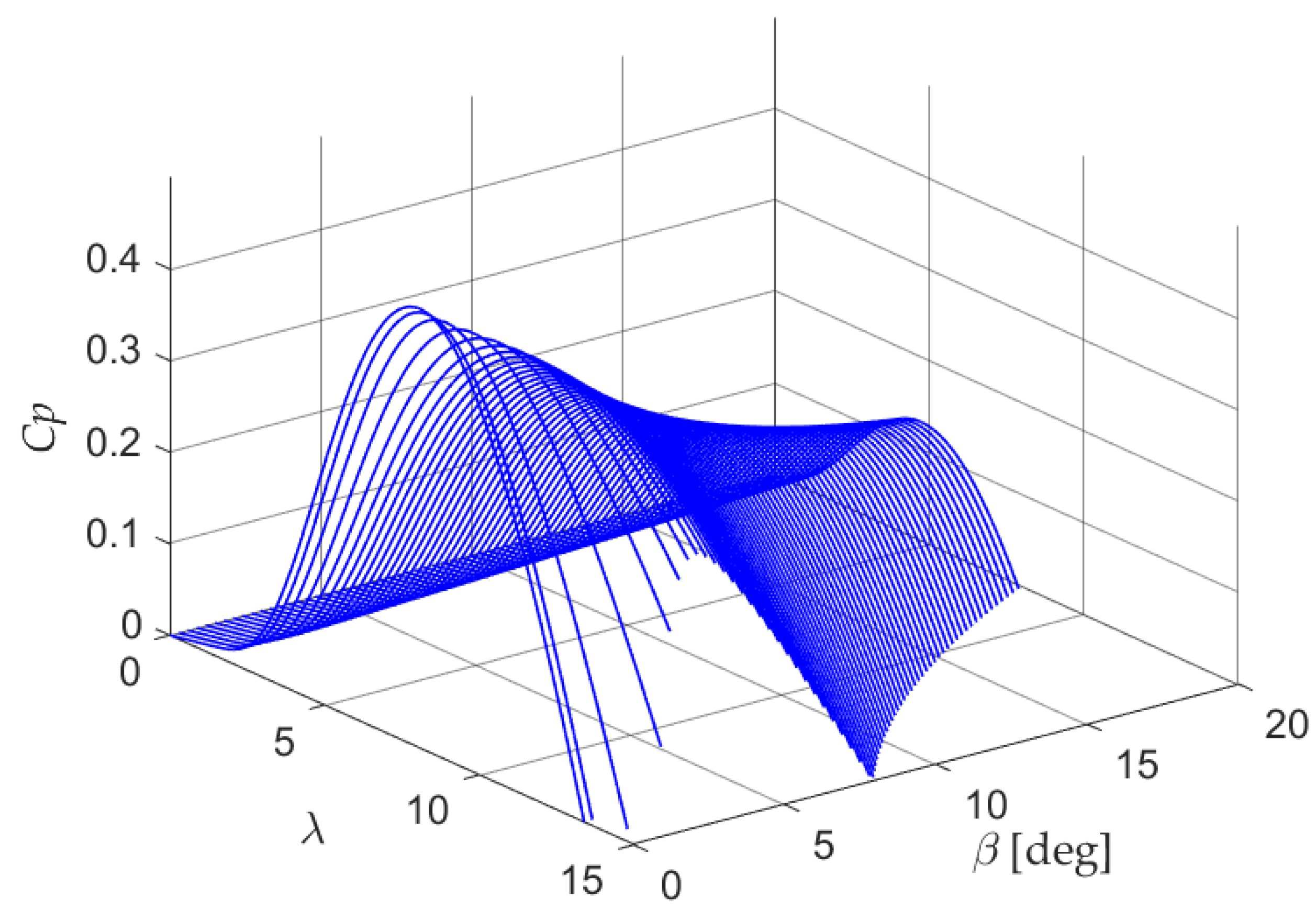

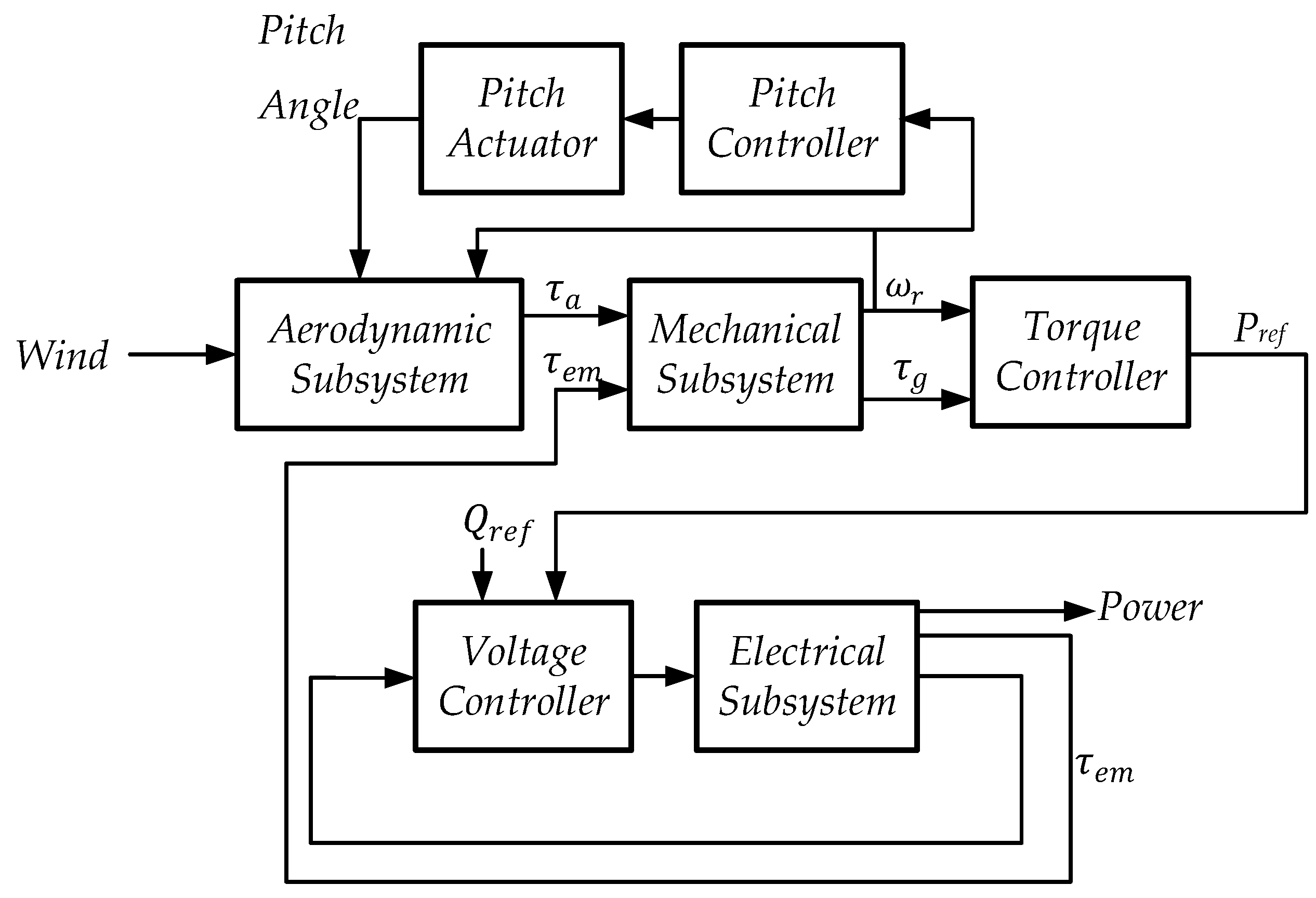

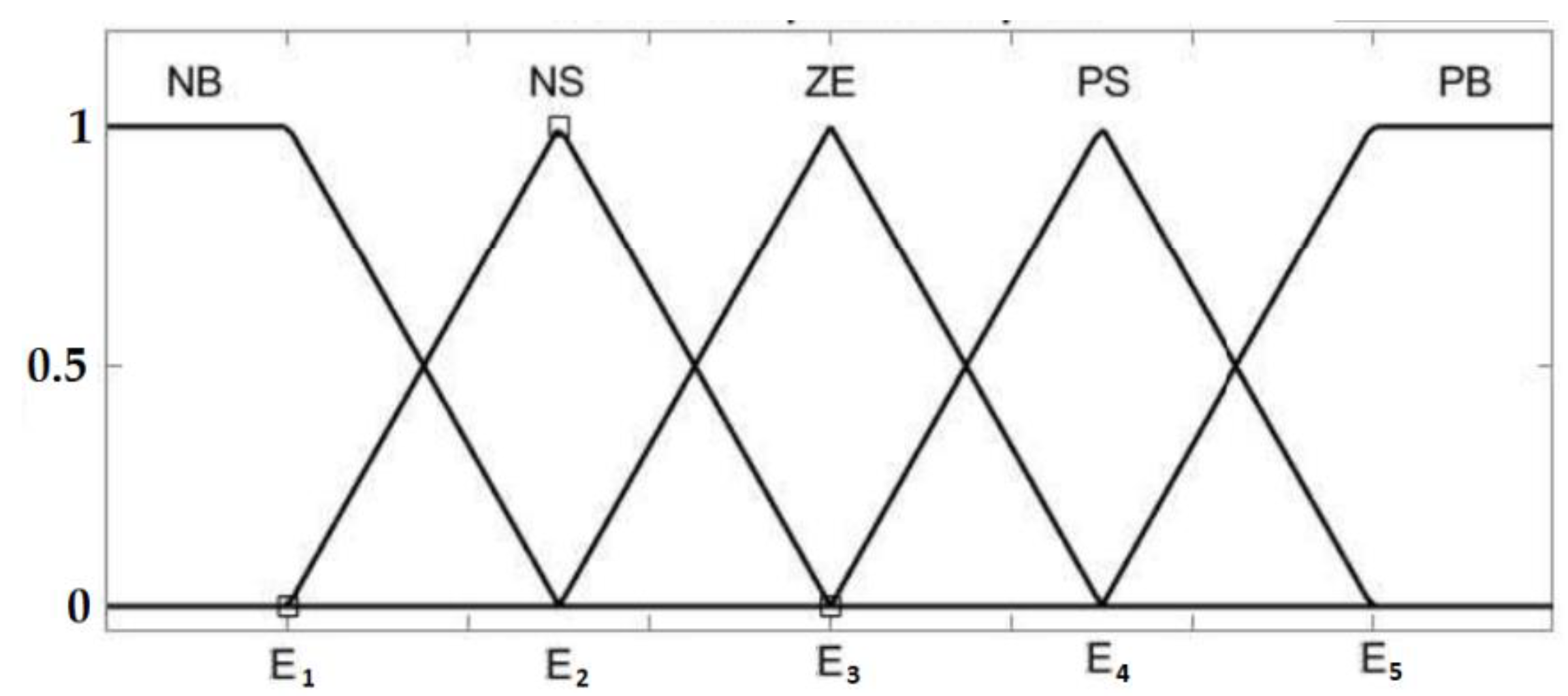
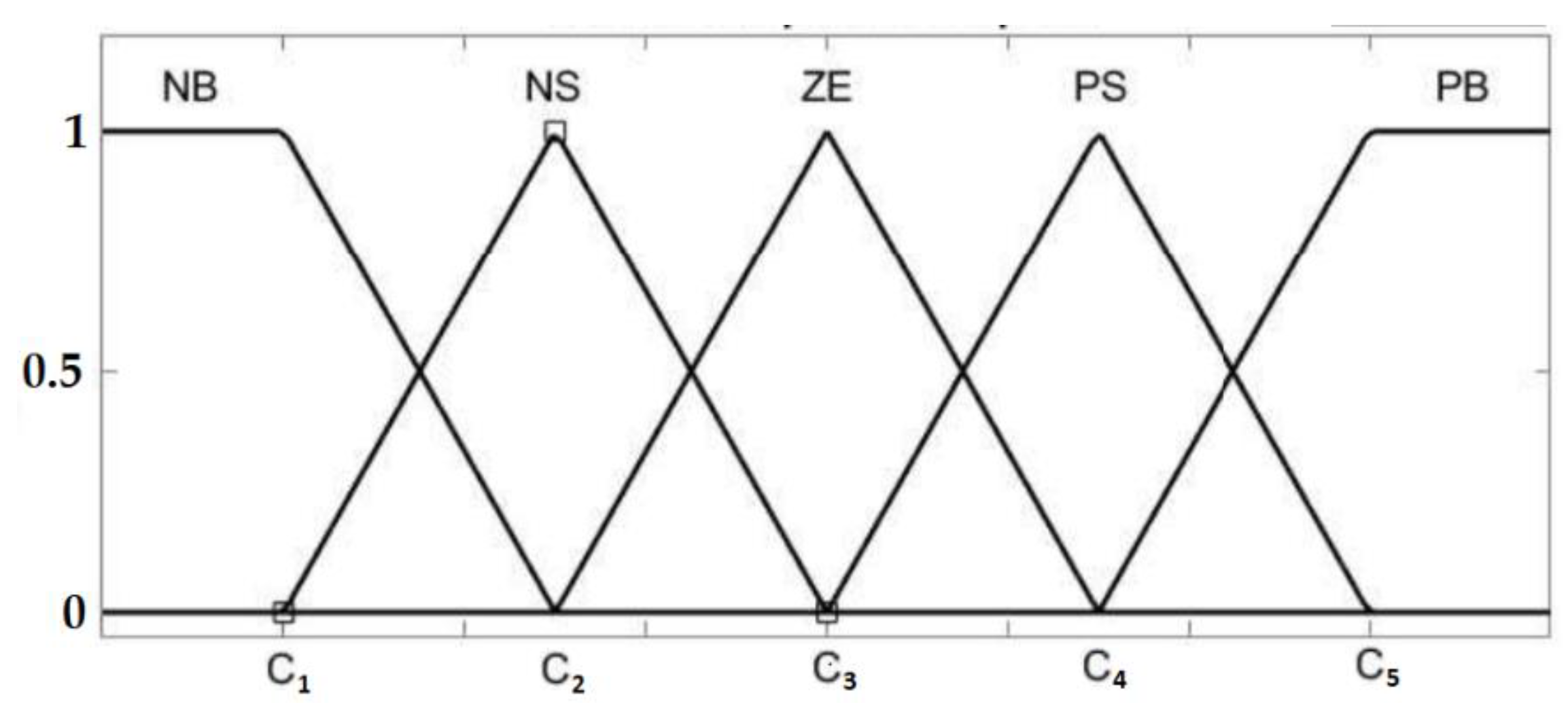

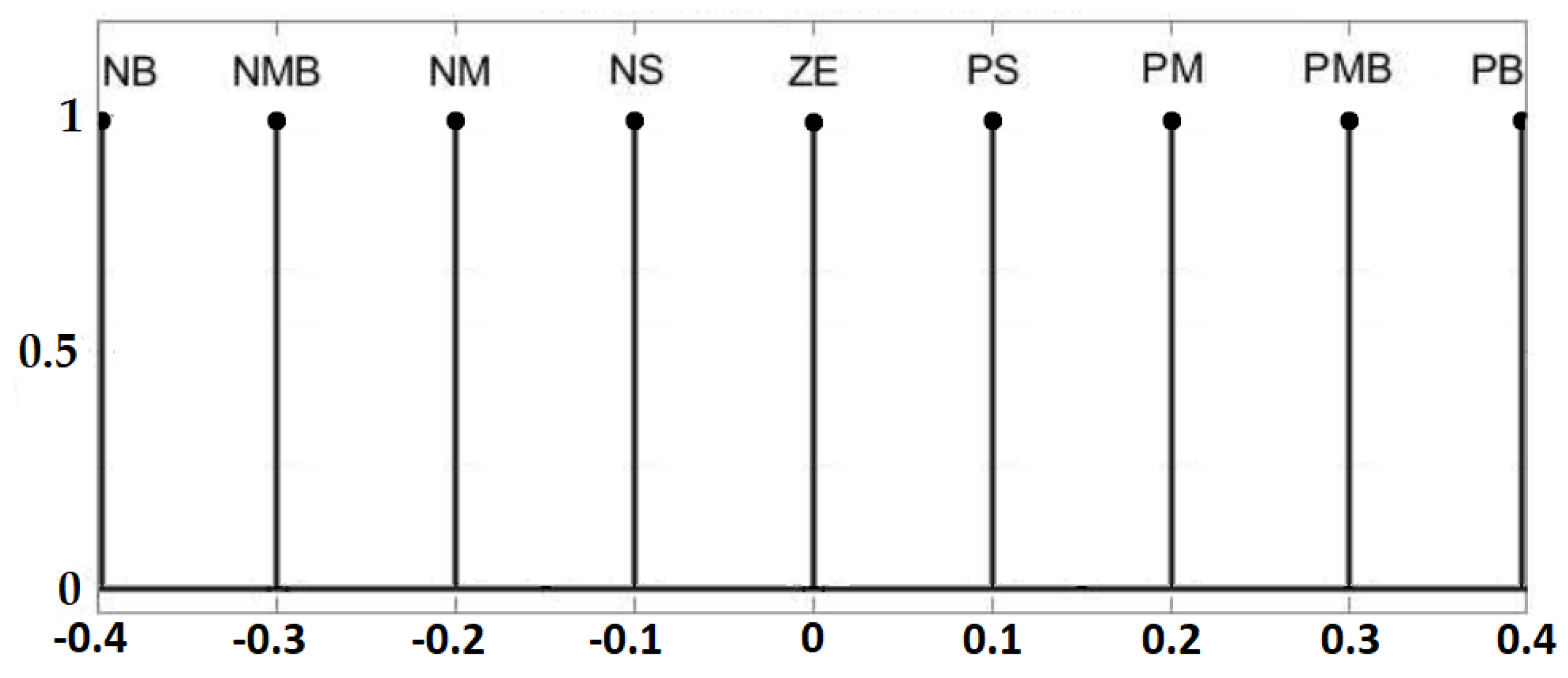
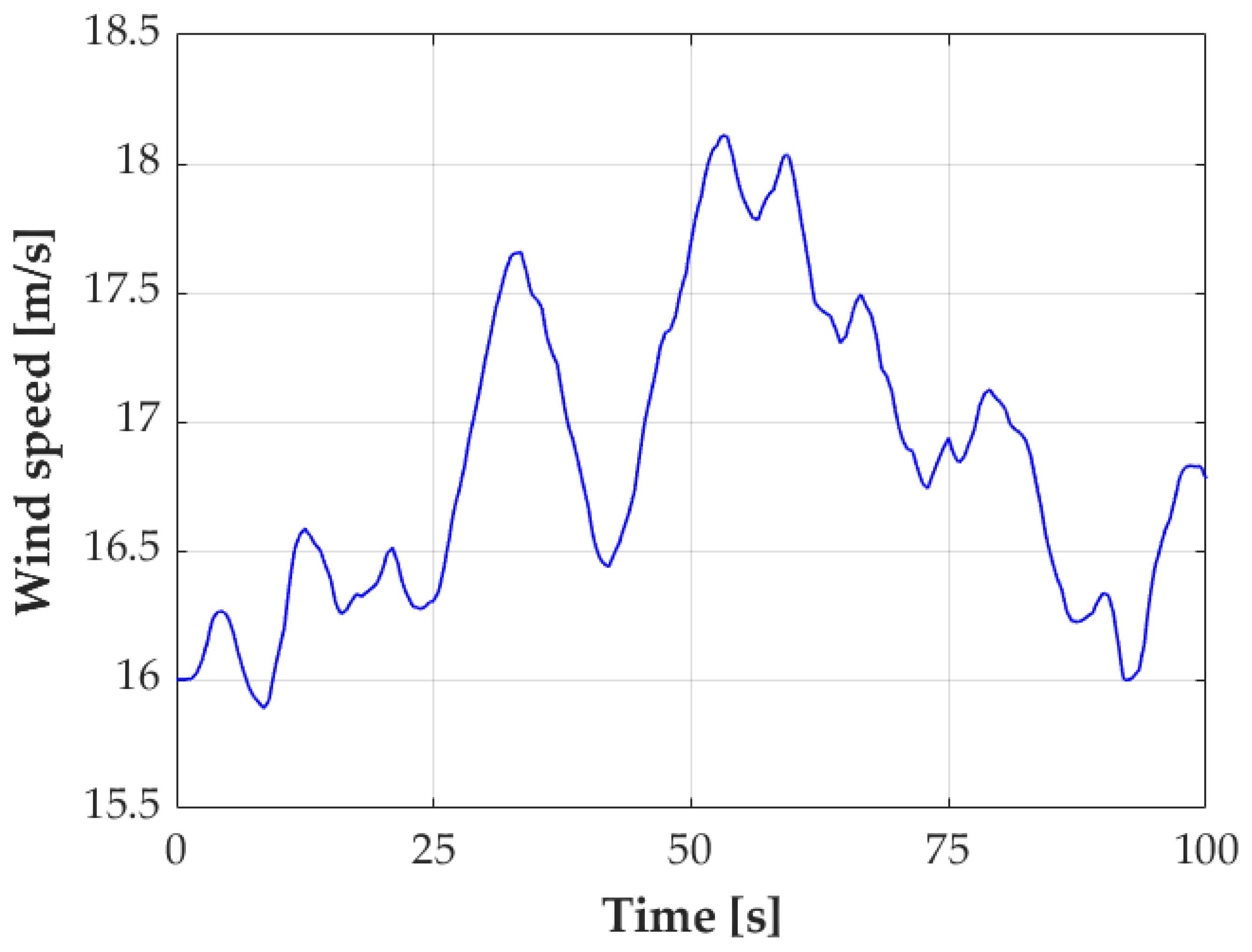
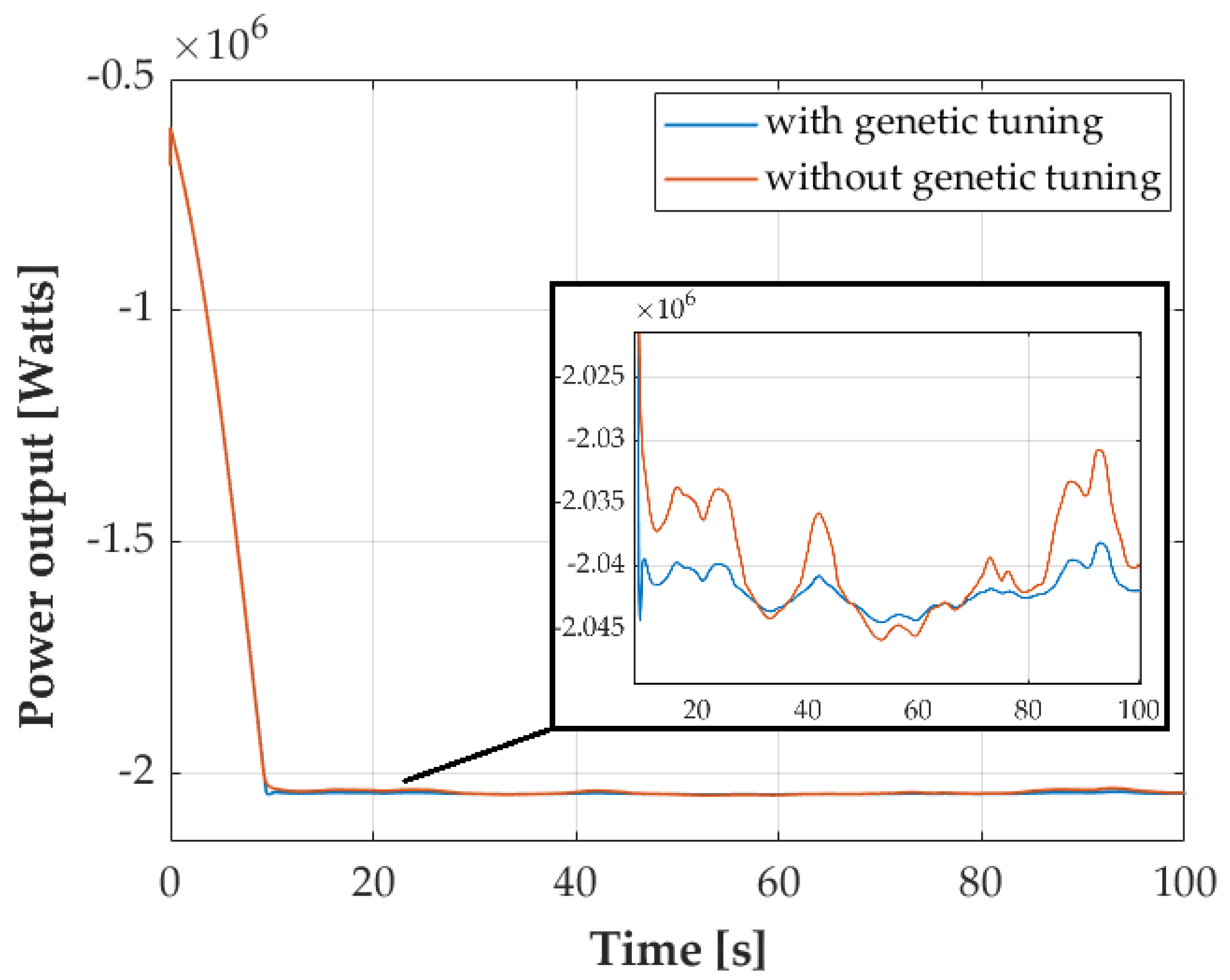


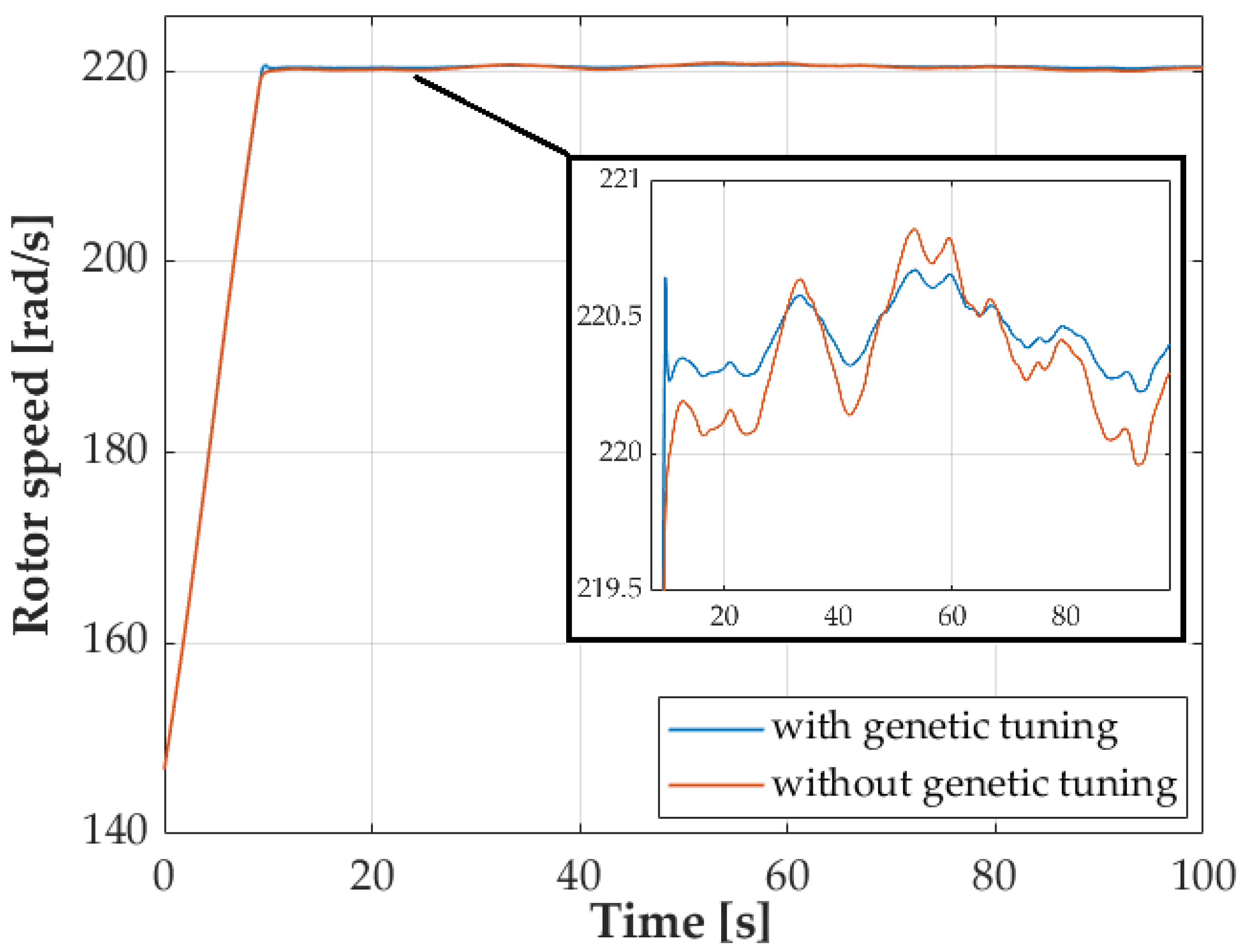
| NB | NS | ZE | PS | PB | ||||||||||||
|---|---|---|---|---|---|---|---|---|---|---|---|---|---|---|---|---|
| NM | ZE | PM | NM | ZE | PM | NM | ZE | PM | NM | ZE | PM | NM | ZE | PM | ||
| NB | NB | NS | PS | NB | NS | PS | NB | NS | PM | NB | PM | PMB | NMB | PMB | PB | |
| NS | NB | NS | PS | NB | NS | PS | NB | ZE | PMB | NMB | PM | PMB | NMB | PMB | PB | |
| ZE | NB | NS | PS | NB | ZE | PM | NMB | ZE | PMB | NMB | PM | PB | NM | PMB | PB | |
| PS | NB | NS | PM | NMB | ZE | PM | NMB | ZE | PB | NM | PMB | PB | NM | PMB | PB | |
| PB | NMB | ZE | PM | NMB | ZE | PM | NM | PS | PB | NM | PMB | PBPB | NM | PMB | PB | |
| Variable | Interval | Value | Variable | Interval | Value |
|---|---|---|---|---|---|
| Parameter | |
|---|---|
| Nominal Output Power | 2 MW |
| Working Mode | Grid Connected |
| Cut-in wind speed | 3 m/s |
| Nominal wind speed | 12 m/s |
| Cut out wind speed | 25 m/s |
| Rotor Diameter | 82.6 m |
| Rotor Swept Area | 5359 m2 |
| Nominal Rotor Speed | 15.8 rpm |
| Gear Box Rate | 1:94.7 |
| Generator Pole Pair | 2 |
| Generator Type | DFIG |
| Generator Synchronous Speed | 1500 rpm |
| Generator Voltage | 690 V |
| Nominal Generator Speed | 220 rad/s |
Publisher’s Note: MDPI stays neutral with regard to jurisdictional claims in published maps and institutional affiliations. |
© 2022 by the authors. Licensee MDPI, Basel, Switzerland. This article is an open access article distributed under the terms and conditions of the Creative Commons Attribution (CC BY) license (https://creativecommons.org/licenses/by/4.0/).
Share and Cite
Pehlivan, A.S.; Bahceci, B.; Erbatur, K. Genetically Optimized Pitch Angle Controller of a Wind Turbine with Fuzzy Logic Design Approach. Energies 2022, 15, 6705. https://doi.org/10.3390/en15186705
Pehlivan AS, Bahceci B, Erbatur K. Genetically Optimized Pitch Angle Controller of a Wind Turbine with Fuzzy Logic Design Approach. Energies. 2022; 15(18):6705. https://doi.org/10.3390/en15186705
Chicago/Turabian StylePehlivan, Ahmet Selim, Beste Bahceci, and Kemalettin Erbatur. 2022. "Genetically Optimized Pitch Angle Controller of a Wind Turbine with Fuzzy Logic Design Approach" Energies 15, no. 18: 6705. https://doi.org/10.3390/en15186705







